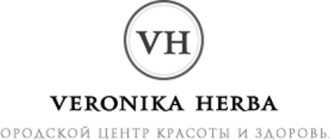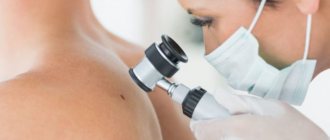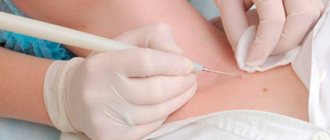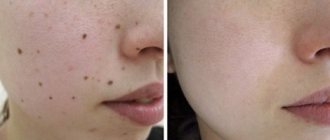During menstruation, the pain threshold is lowered, and recovery takes longer. Pregnant women should postpone the procedure for the same reasons. Any changes/disturbances in hormonal levels can make laser wart removal ineffective.
Contraindications also include some diseases:
- dermatological;
- infectious;
- viral;
- endocrine;
- cardiovascular;
- hormonal;
- oncological;
- autoimmune, etc.
In case of exacerbation of chronic disorders or deterioration of health, it is advisable to reschedule the procedure.
Features of the laser wart removal procedure
Therapy is not carried out if it is necessary to preserve the tumor tissue for further study. Warts are not simply removed: the device completely destroys biological material. So it is impossible to combine laser with histological examination. Samples can only be taken before the procedure is scheduled, otherwise the patient is offered other methods
Preliminary consultation is required. A dermatologist performs a visual examination and collects anamnesis to identify contraindications. The absence of visible diseases is confirmed by the results of a general blood test.
If there are no health problems, the patient is sent for examination to an oncologist. It is important to make sure in advance that the nevus being removed is a benign tumor. This will eliminate some possible complications, including the risk of developing cancer cells.
How nevi are removed
You need to get rid of moles on time and only in a cosmetology clinic. They are subject to mandatory removal if they are located:
- on the neck and face (especially in men and boys, since it is easy to damage the nevus when shaving);
- in the groin and genitals;
- at the waist (will be subject to constant friction against clothing);
- along the bra line for girls and women.
Before removal, you should definitely listen to your doctor’s recommendations. The specialists of the PRAGA clinic work with each patient delicately and take responsibility for your health. If during the examination there is concern that a mole has signs of melanoma, our doctor will definitely send you for examination and histology.
How does the laser wart removal procedure work?
Therapy is started after examination. The procedure is performed on an outpatient basis - immediately or on a previously agreed day.
Laser removal consists of 4-5 stages:
- Disinfection. The skin is prepared by cleaning it from street dust, as well as remnants of cosmetics or care products. Next comes mandatory disinfection - the treated area is wiped with an antiseptic.
- Anesthesia. If desired, local anesthesia is acceptable; doctors use various gels, sprays or ointments. And for large warts, they offer pain relief with an injection administered subcutaneously. General anesthesia is rarely used and only in certain situations.
- Equipment setup. The specialist selects the power and wavelength, adjusting the laser to the patient’s problem.
- Delete. Sequential heating and destruction of neoplasm cells are carried out. The laser does not affect surrounding tissues.
- Repeated disinfection. The doctor disinfects the treated area and gives recommendations for care.
To avoid contamination, the wound is covered with a plaster or bandage. Clinics often sell products that accelerate regeneration; with them, the skin will heal faster. Removing a small wart will not cost much, but anesthesia and some consumables may not be included in the basic cost.
Strengthening the immune system
Modern medicine has not yet learned to kill viruses. But an important fact is that HPV carriage is not lifelong. In addition, medicine has a small number of means at its disposal that allow it to remove some of the viruses from the body. The use of these drugs is fully compatible with immunomodulatory therapy.
The amount of virus in the body is directly related to the state of the body’s immunity - the better the immunity, the less virus. Therefore, the most promising way to reduce the concentration of HPV in the body is to strengthen the immune system. For this purpose, a separate course of treatment is carried out, after which the person begins to feel much better.
Finally, there are very effective preparations for topical use - creams, gels, sprays that increase local immunity and reduce the concentration of the virus in the affected tissues.
Number of required procedures
To eliminate a small wart or mole, it is enough to do 1 procedure. Often a session takes no more than 10 minutes, and only when working with a large area does the process last for half an hour or even an hour. During this time, the specialist completely removes the unwanted formation.
In rare cases, dermatologists offer a course of 2-3 sessions, the required interval is at least 7 days. This option is used for patients with sensitive skin, especially if it is necessary to treat a large number of moles or papillomas.
More often, removal in several stages is carried out for highly overgrown formations. If all rules of procedure and care are followed, there is no need for prophylaxis.
Self-medication is harmful
Do not try to diagnose and treat HPV infection on your own! Firstly, there is a risk of improper use of drugs. Secondly, only a doctor can distinguish papilloma from a malignant tumor. In addition, self-treatment is fraught with consequences.
Today, there are celandine-based preparations on sale that are intended to eliminate warts. Celandine juice is similar in composition to iodine. Therefore, prolonged exposure to the drug causes skin burns. In this case, papillomas are seriously injured and can provoke the development of skin cancer. Cauterization with iodine is even more dangerous - it is more aggressive than celandine. Trying hard to get rid of papillomas with iodine, you can get scars on the skin. Vinegar is no better in this regard. Attempts to bandage warts and papillomas with a thin silk thread often only provoke the growth of these formations.
If you suspect the appearance of warts or genital warts, you should definitely seek advice from a dermatologist, urologist or gynecologist, depending on the location of the source of infection. Only a professional can correctly diagnose the disease and prescribe the necessary treatment.
Advantages and disadvantages of the laser method
Advantages of the laser wart removal technique:
- no age restrictions;
- use for any part of the body;
- there is no bleeding;
- high performance;
- impact directly on education;
- relatively fast healing process;
- painlessness;
- low probability of relapse;
- in most cases it does not leave scars.
The laser device seals the vessels without affecting the surrounding tissue, which minimizes the risk of infection. Modern lasers are equipped with a cooling system to make the procedure painless. And for sensitive skin, local or general anesthesia is provided.
Disadvantages of the method:
- high price;
- the speed and quality of recovery depend on the patient’s characteristics;
- errors during the procedure/rehabilitation lead to complications;
- there is no guarantee of no relapses.
When removing formations on the feet, a person cannot walk for some time. In addition, a removed mole can no longer be checked for benignity: an examination must be carried out before the procedure.
HPV and warts
HPV is a whole group of viruses that infect humans. Several dozen strains of HPV can live in the body of one person, but this does not pose any threat to health if you have a strong immune system and do not have serious chronic diseases that weaken it. HPV does not manifest itself in any way until the body’s immune functions decrease to a certain level. If you notice warts on yourself, you should think first not about the aesthetic appearance of your skin, but about your health.
It is worth understanding that HPV is not some rare disease. It occurs in at least half of the world's population, it simply does not manifest itself, and is dangerous only in a number of cases.
Infection with the human papillomavirus occurs during sexual intercourse or kissing, when sharing personal hygiene items - towels, washcloths, nail scissors, etc.
Consequences and possible complications
Common consequences include the formation of scars and scars at the site of nevi. Scars are possible when a large area is exposed to the laser, as well as when “deep” warts are removed.
Sometimes scars occur for other reasons:
- individual predisposition;
- infection or damage to the wound;
- incorrect device settings (medical oversight);
- lack of care or errors during the rehabilitation period.
Immediately after the procedure, the skin may:
- blush;
- to swell;
- get sick;
- itch and itch.
This is a normal reaction to the procedure, as well as a short-term increase in temperature. But if the discomfort does not disappear within 5 days or longer, it is advisable to consult a doctor. Consultation is also necessary in cases where the treated area suddenly begins to hurt or swell.
Possible complications:
- High laser power may cause blisters and burns. They can also form when the depth of the wart is incorrectly determined.
- If a mole is removed partially or incorrectly, it can grow back. In rare situations, a benign tumor develops into melanoma.
Trauma to the sore leads to the development of secondary complications:
- infection;
- non-healing wound;
- persistent swelling or redness;
- formation of pronounced scars;
- hyperpigmentation.
When eliminating formations on the lower extremities, the risk of negative consequences is higher. Reviews indicate that laser removal of plantar warts occurs without serious complications. But for this, you must stay at home throughout the recovery period.
Why are traditional methods of treatment dangerous?
Many people remember cauterization with celandine, iodine and vinegar from childhood. Some people removed warts using a silk thread, while others applied hot metal objects to them to burn them out! All these methods are not only ineffective in the fight against warts and HPV, but also dangerous to human health.
As a result of such “home” treatment, a child or adult can receive multiple burns, scars and welts, and removal with a thread only provokes further growth and spread of papillomas on the skin.
We live in the 21st century, where there are modern methods of treatment and correction that are safe for health. If you find papillomas on the skin or mucous membranes, first make an appointment with a dermatovenerologist or gynecologist. The doctor will prescribe treatment and, if necessary, refer you to a surgeon for quick removal of the papilloma.
The MC “Health” network welcomes doctors - gynecologists, dermatovenereologists and surgeons with extensive experience. Hundreds of patients come to appointments with external manifestations of HPV, and our specialists consider each case individually - prescribe the necessary tests and studies, adjust treatment, and help quickly cope with the disease. You can make an appointment with any doctor on the clinic’s website.
Don’t delay the examination and get treatment from professionals!
Is it painful to remove a wart with a laser?
Soreness is influenced by 5 factors:
- treated area;
- size and depth of the nevus;
- laser type;
- duration of the procedure;
- pain threshold.
For small moles, cauterization is sufficient, while formations with a deep-lying core are more difficult to remove. In the first case, anesthesia is optional; some people voluntarily refuse it. The reason may be simple economy or allergies. Therefore, some of the reviews about laser wart removal are written about the painful procedure.
The use of local anesthesia in combination with modern equipment minimizes discomfort. For particularly complex cases, general anesthesia is acceptable.
Advantages of tumor removal in Telos Beauty Prof
- Safety. Our doctor precisely affects the area of skin, clearly regulates the intensity of the beam and the depth of laser exposure. The ability to carry out the procedure on any area: face, neck, décolleté, back, arms, body.
- Quality. The high level of knowledge and extensive practice of doctors allow us to carry out procedures with minimal trauma, no complications and a short recovery period. Can be used on skin of any color.
- Comfort. The most painless analogue among other laser procedures. We use anesthesia to ensure comfort during the procedure.
- Result guarantee. A powerful effect, our doctors use their own methods of combined procedures to achieve 100% results.
- Escort. We take care of you throughout the entire period of rehabilitation, monitor and answer all questions.
- Rehabilitation. Fast recovery period, our clients undergo rehabilitation procedures with a discount of up to 50%.
- Effect. The result is noticeable immediately. Due to the correctly selected method of influence, a sustainable effect is achieved.
Is it permissible to perform laser removal of warts in children?
Laser equipment is used to eliminate warts and port-wine stains without any age restrictions. The technique allows you to avoid possible complications after surgery; it is indicated in the presence of contraindications to alternative procedures.
It is impossible to eliminate the defect with internal medications or folk remedies. In some cases, birthmarks resolve on their own by the first year of life, but there are circumstances in which removal is preferable:
- it is painful for the child to walk or move;
- the defect interferes with movement and injury can easily occur;
- there is a risk of disfigurement of appearance;
- increasing the size of the formation.
Children under 5 years of age are susceptible to developing heel warts. As in the situation with “spots,” they can disappear on their own in 1-2 years. No treatment is required; consult a doctor only if there are suspicious symptoms or severe discomfort.
Reviews about laser removal of a plantar wart for a child are mostly positive, and relapses occur extremely rarely.
The mechanism of warts appearance
You can become infected with warts, that is, you can become infected with the virus itself, which provokes the appearance of these tumors that are unpleasant to look and feel (more than 60 types of papillomavirus are the causative agents of the disease). The simplest and most common way of infection is tactile contact (a simple handshake, friendly contact, a walk holding hands). You can also become infected through any household items, on public transport, through door handles, and so on. The virus lives in the external environment for about 2-3 hours. After the virus enters the skin, it penetrates through microcracks into the deep layers and settles in the nervous tissue (this is why warts often appear during stress, depression, nervous strain and nervous shock). It has also been noted that persons suffering from excessive sweating are susceptible to the disease. Therefore, it is no coincidence that from childhood we are taught to wash our hands after going outside, before eating, after coming home from school.
Plantar warts appear when wearing low-quality shoes, which provoke constant sweating of the feet, and since a damp environment is a favorite place for the virus, a person has a high probability of developing the disease in this particular part of the body. This is most often observed in children and adolescents. Usually a person may not even be aware that he is a carrier of the virus. But one day he will definitely unexpectedly discover a tumor on his hand (or in another place). The virus in the human body can live for more than one year until the moment when some provoking factor provokes the virus to come out (for example, the same severe stress). The virus moves freely along nerve pathways, so a wart can appear in the most unpredictable place (but there are also those that appear in the same place all the time, with some frequency). There is also a possibility that they will never appear, even if the person is a carrier of the virus.
Now it should be said that the relevance of this problem is due not only to cosmetic defects and aesthetics, but also to the possibility of malignant degeneration (there is a category of warts that over time can degenerate into a malignant tumor).
Wound healing time after laser wart removal
Immediately after the procedure, the doctor treats the problem area with an antiseptic. A small wound and redness remain at the site of formation: it is covered with a plaster or elastic bandage. For the first 3 days, the damaged area should not be touched or wet.
After laser removal of warts, the wound heals from 7 to 14 days. On the 3-5th day it becomes covered with a crust (scab), the condition of which must be monitored. Do not allow damage, and do not try to soak or remove ahead of time - the sore will go away on its own.
On average, it takes from 1 to 4 months for complete skin restoration. This period is individual and depends on the individual patient. The wound can take quite a long time to heal if the immune system is weakened for any reason.
Postoperative period
After removing a wart, a crust forms in its place, which is prohibited from being picked off yourself. Removing the scab before it dries can result in a scar. After some time, it will dry out on its own and disappear, provided that the doctor’s instructions are followed.
After the removal procedure, it is recommended to follow simple rules to eliminate the risk of complications:
- Avoid visiting saunas, baths, swimming pools, as well as taking a bath, so as not to wet the crust and not expose it to wet steam;
- Use protection from ultraviolet rays;
- Do not use cosmetics on the area where the wart was removed;
- Do not cover the wound with a band-aid;
- Treat the wound with a disinfectant;
- Take medications prescribed by your doctor.










